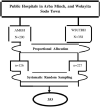Magnitude of second-trimester-induced abortion and associated factors among women who received abortion service at public hospitals of Arba Minch and Wolayita Sodo towns, southern Ethiopia: A cross-sectional study
- PMID: 36312870
- PMCID: PMC9614144
- DOI: 10.3389/fgwh.2022.969310
Magnitude of second-trimester-induced abortion and associated factors among women who received abortion service at public hospitals of Arba Minch and Wolayita Sodo towns, southern Ethiopia: A cross-sectional study
Abstract
Introduction: Second-trimester abortion accounts for 10-15% of all induced abortions, with varying rates across countries, and is responsible for two-thirds of major abortion complications. It is also associated with higher medical costs, morbidity, and mortality rates than first-trimester abortion. Even though it is a significant burden, there is a lack of adequate information about second-trimester-induced abortion, especially in the study area. As a result, the primary purpose of this study is to fill this research gap and assess the magnitude and associated factors of second-trimester-induced abortion in the public hospitals of Arba Minch and Wolayita Sodo towns, southern Ethiopia.
Methods: A facility-based cross-sectional study was conducted. Systematic sampling was used to select 353 study participants. Data were collected through face-to-face interviews using a structured questionnaire and record review by using Kobo collect version 3.1. Analysis was done by STATA 14. Logistic regression was used to identify associated factors of the second-trimester-induced abortion.
Results: The magnitude of second-trimester-induced abortion in the study setting was 23% (95%CI: 18.5%, 27.4%). The factors associated with second-trimester-induced abortion among women received abortion care services were respondent's age 25-29 and 30-34 years old (AOR = 0.38, 95%CI:0.15, 0.96 and (AOR = 0.31, 95%CI:0.10, 0.97, respectively), planned pregnancy (AOR = 0.22, 95%CI:0.11, 0.44), and delay confirming pregnancy (AOR = 2.21, 95%CI:1.15, 4.23).
Conclusion: This study showed that more than one-fifth of women who presented for abortion care services had second-trimester-induced abortions. Health institution organizations working on maternal health at various levels should provide counseling to women to help them early confirm their pregnancy and make decisions about whether or not to continue it as early as possible.
Keywords: Ethiopia; abortion service; associated factors; magnitude; second-trimester-induced abortions.
Copyright © 2022 Abebe, Mersha, Degefa, Molla and Wudneh.
Conflict of interest statement
The authors declare that the research was conducted in the absence of any commercial or financial relationships that could be construed as a potential conflict of interest.
Figures

Similar articles
-
Epidemiology of second trimester induced abortion in Ethiopia: a systematic review and meta-analysis.Front Glob Womens Health. 2025 Apr 28;6:1452114. doi: 10.3389/fgwh.2025.1452114. eCollection 2025. Front Glob Womens Health. 2025. PMID: 40357003 Free PMC article.
-
Determinants of induced abortion among women received maternal health care services in public hospitals of Arba Minch and Wolayita Sodo town, southern Ethiopia: unmatched case-control study.BMC Womens Health. 2022 Apr 9;22(1):107. doi: 10.1186/s12905-022-01695-0. BMC Womens Health. 2022. PMID: 35397584 Free PMC article.
-
Health facilities readiness to provide comprehensive abortion care and factors associated with client satisfaction in Central Oromia Region, Ethiopia: a multilevel modeling approach.Reprod Health. 2023 May 11;20(1):72. doi: 10.1186/s12978-023-01610-2. Reprod Health. 2023. PMID: 37170219 Free PMC article.
-
Determinants and Outcome of Safe Second Trimester Medical Abortion at Jimma University Medical Center, Southwest Ethiopia.J Pregnancy. 2019 Jul 7;2019:4513827. doi: 10.1155/2019/4513827. eCollection 2019. J Pregnancy. 2019. PMID: 31360549 Free PMC article. Clinical Trial.
-
Induced second trimester abortion and associated factors in Amhara region referral hospitals.Biomed Res Int. 2015;2015:256534. doi: 10.1155/2015/256534. Epub 2015 Mar 30. Biomed Res Int. 2015. PMID: 25918704 Free PMC article.
Cited by
-
Magnitude of late presentation for induced abortion care services and the associated factors among reproductive-age women at selected hospitals in the South Gondar district of Northwest Ethiopia in 2023: a multicentred, cross-sectional study.BMJ Open. 2024 Nov 20;14(11):e081946. doi: 10.1136/bmjopen-2023-081946. BMJ Open. 2024. PMID: 39572098 Free PMC article.
-
The magnitude of second-trimester induced abortion and associated factors in Ethiopia: a systematic review and meta-analysis.Front Glob Womens Health. 2025 Jul 1;6:1535329. doi: 10.3389/fgwh.2025.1535329. eCollection 2025. Front Glob Womens Health. 2025. PMID: 40666252 Free PMC article.
-
Epidemiology of second trimester induced abortion in Ethiopia: a systematic review and meta-analysis.Front Glob Womens Health. 2025 Apr 28;6:1452114. doi: 10.3389/fgwh.2025.1452114. eCollection 2025. Front Glob Womens Health. 2025. PMID: 40357003 Free PMC article.
-
Delays in seeking abortion and its determinants among reproductive-age women based on the Ethiopian Demographic and health survey.Heliyon. 2024 Sep 26;10(19):e38477. doi: 10.1016/j.heliyon.2024.e38477. eCollection 2024 Oct 15. Heliyon. 2024. PMID: 39430523 Free PMC article.
References
-
- Pranavi B, George N, Saraswathi K. A clinical observational study on second-trimester abortion. (2020) 9:1339–46.
-
- Bearak J, Popinchalk A, Ganatra B, Moller A-B, Tunçalp Ö, Beavin C, et al. . Unintended pregnancy and abortion by income, region, and the legal status of abortion: estimates from a comprehensive model for 1990–2019. Lancet Global Health. (2020) 8:e1152–61. 10.1016/S2214-109X(20)30315-6 - DOI - PubMed
LinkOut - more resources
Full Text Sources
Research Materials
Miscellaneous

